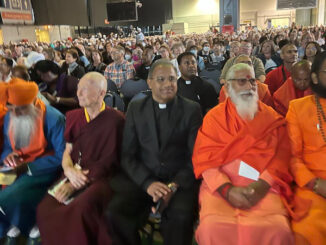

“The only way the U.S. can expand its lead in Science and Technology is by working together with the scientists in India. According to a recent report in the Times of India, India is all set to produce the world’s largest number of engineers. While 85% Indian men have shown interest in engineering, the number stands at a close 79% among women in India”, says the author.
“Science & Engineering Indicators”, a voluminous document, describing the state of American technology was just released by the National Science Foundation and National Science Board. This contains facts and figures on research and development, innovation and engineers. But the report’s startling conclusion lies elsewhere: China has become—or is on the verge of becoming—a scientific and technological superpower.
After all, science and technology constitute the knowledge base for economically advanced societies and military powers, and China aspires to become the world leader in both. Still, the actual numbers are breathtaking for the speed with which they have been realized.
25 years ago, China’s economy was tiny, and its high-tech sector barely existed. Since then, here is what has happened.
China has become the second largest R&D spender, accounting for 21 per cent of the world total of nearly $2 trillion in 2015. Only the U.S., at 26% ranks higher, but if present growth rates continue, China will soon become the biggest spender. From 2000 to 2015, Chinese R&D outlays grew an average of 18% annually, more than 4 times faster than the U.S. rate of 4%.
There has been an explosion of papers on technology by Chinese teams. Although the U.S. and the EU each produce more studies on biomedical subjects, China leads in engineering studies. American papers tend to be cited more often than the Chinese papers, suggesting that they involve more fundamental research questions, but China is catching up.
China has dramatically expanded its technology workforce. From 2000 to 2014, the annual number of bachelor’s degree graduates went from about 359,000 to 1.65 million. Over the same period, the comparable number of U.S. graduates went from 483,000 to 742,000. This includes graduates of Chinese and Indian origin, may be 50%.
Much of China’s high-tech production once consisted of assembling sophisticated components made elsewhere. Now, says the report, it is venturing into demanding areas such as “supercomputers and smaller jetliners.”
China still lags in patents received. Over the past decade, American firms and inventors account for about half the US patents annually. I should point out that there are so many eminent Indian American scientists and technologists who have accumulated large number of patents. 40% of start-ups in the Silicon Valley are started by Indians.
Zero and mathematics were invented in India. Algebra, Trigonometry, and Decimal /Fraction systems were invented in India. Albert Einstein said that without zero there is no computer or internet. The Indian Institute of Technology is the topnotch in the world. A degree from IIT is equal to combined degrees from Harvard, M.I.T. and Princeton stated Leslie Stahl, CBS 60 Minutes anchor after she visited the IIT’s in India. Sir C.V. Raman of Bangalore won a Nobel prize in Physics several centuries ago. So many other Indians have also won the Nobel prize in Science. Professor Ramanujan of Cambridge University, U.K. has made original contributions to advanced mathematics. Laser Technologist, Bhowmik of Los Angeles had 100 patents.
The only way the U.S. can expand its lead in Science and Technology is by working together with the scientists in India. According to a recent report in the Times of India, India is all set to produce the world’s largest number of engineers. While 85% Indian men have shown interest in engineering, the number stands at a close 79% among women in India.
In India, the Software services industry alone recruits about 300,000 people every year. Engineering tops the list of professions seen as most vital for economic growth.
TRUMP OFFERS TO SHARE 100% of U.S. TECHNOLOGY
President Trump has made a huge policy change benefitting India. Trump stated that the US will share 100 per cent of all its technology with India and treat India as its closest ally. This will enable American companies to set up shops in India and allow them to transfer technology to Indians. Because of comparative advantage and availability of large supply of engineers, these American companies in joint venture with Indian companies could contribute to scientific and technological revolution, especially R&D.
I recall that after India first tested nuclear bomb the US imposed heavy sanctions against India. This prevented Indian scientists from attending international conventions. This sanction continued for long and never lifted. Only after President George W Bush’s offer of nuclear civil agreement, such sanctions were removed.
If the U.S. and India work hand in hand, China will find difficult to compete for global leadership in Science and Technology.
(The author, a resident of Scarsdale, NY is a former President & CEO, First Asian Securities Corp, NY. An MBA from Columbia Business School, he is the Chairman, India, National Republican Asian Assembly, Washington D.C, and Senior Vice Chairman, Indian American Republican Committee)





Be the first to comment